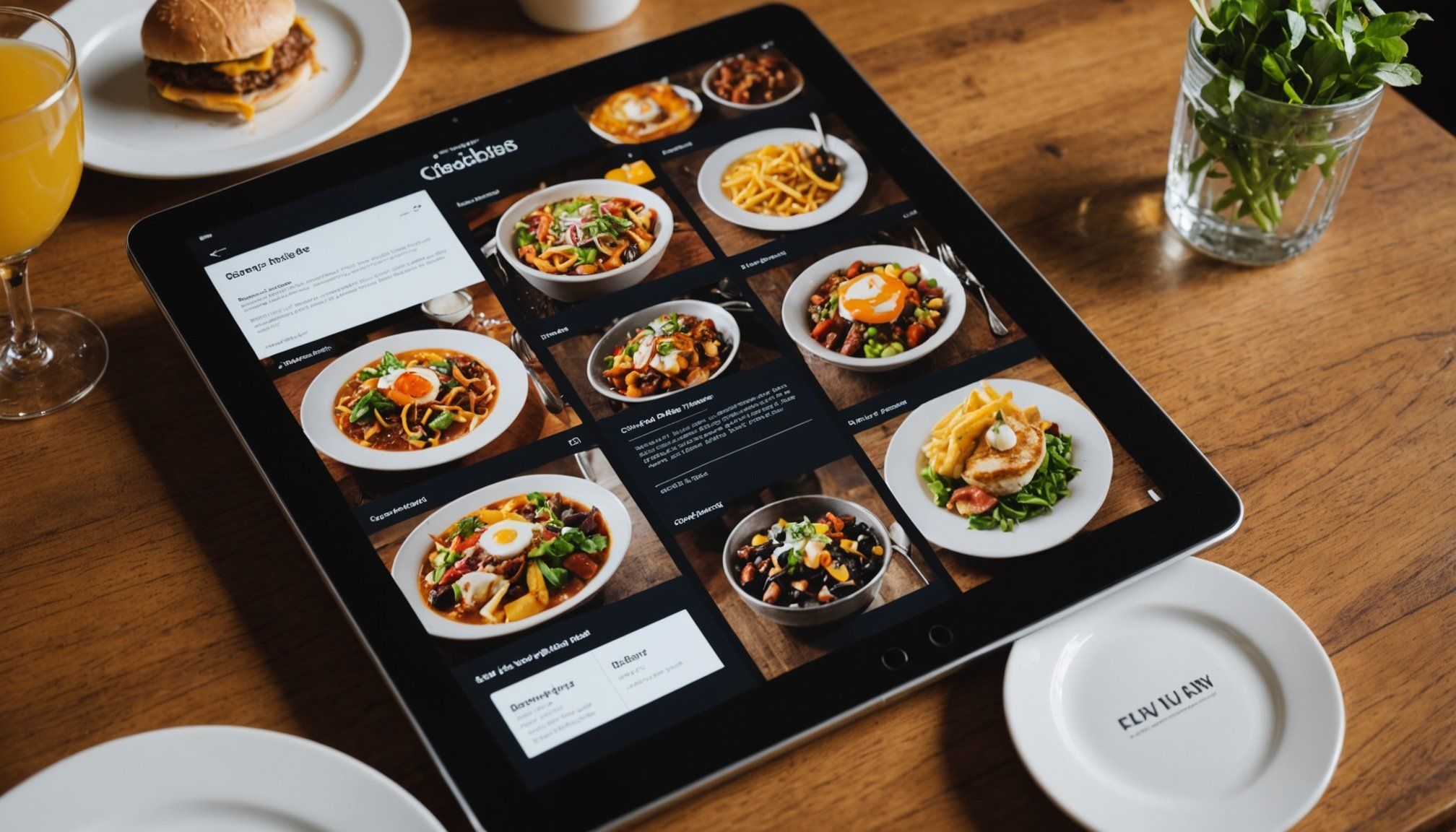Advantages of Digital Menus
Digital menus offer considerable benefits, revolutionising the dining experience by enhancing ordering efficiency and payment processes. Utilising digital menus allows restaurants to streamline operations, reducing the time between a customer’s choice and the final order submission. This efficiency not only speeds up service but also improves table turnover rates, leading to increased revenue.
Another key advantage is customer engagement through interactive features that digital menus provide. Interactive menus can showcase enticing images and videos, easy-to-navigate options, and even interactive promotions. Such features pique customer interest, potentially increasing order value as diners explore and add more items to their virtual cart.
Also to read : Effective Networking Tips to Elevate Your Freelancing Career in the UK
Moreover, digital menus offer unmatched customization options. Diners can tailor their experience according to their preferences, such as ingredient swaps or allergen highlights. This capability ensures the customer’s dietary needs are met while also personalising their dining experience, fostering customer loyalty.
Overall, the steady shift towards digital menus addresses both the demand for quicker service and heightened customer interaction, offering a modern solution to enhance the dining experience significantly. By incorporating these innovative features, restaurants can cater to evolving consumer expectations while simultaneously improving operational efficiency.
Also to read : Harnessing Virtual Reality: The Ultimate Guide for UK Real Estate Agents to Revolutionize Property Showcases
Technological Innovations in Digital Menu Systems
As dining experiences evolve, digital menu technology is at the forefront of innovation, transforming how patrons interact with restaurant menus. One notable advancement is the integration of QR code technology, which allows diners to access menus directly from their smartphones. This innovation not only reduces physical contact with shared menus but also enables real-time updates, ensuring customers always see current offerings.
Another major development is the seamless integration of digital menus with POS systems. This connection streamlines ordering and payment processes, eliminating manual input errors and speeding up transactions. Such efficiency is crucial for maintaining customer satisfaction and increasing table turnover rates.
Interactive features, like 3D food visualizations, play a pivotal role in enhancing user engagement. Diners can view detailed images of dishes, providing a clearer understanding of what to expect. Additionally, digital menus often include dietary filters, allowing guests to easily identify dishes that meet specific nutritional needs.
These cutting-edge technologies not only provide convenience but also enrich the dining experience, catering to the modern diner’s desire for instant access and personalization. As digital menus continue to evolve, they promise to redefine how restaurants engage with their customers.
Consumer Reactions to Digital Menus
Digital menus have transformed the dining habits of consumers, eliciting a range of feedback and shifting preferences. According to survey data, many diners appreciate the convenience and versatility of digital menus over traditional ones. They report increased satisfaction due to enhanced customization options and the ability to view interactive features and detailed descriptions.
However, some consumers express concerns about the over-reliance on technology. Certain demographics, particularly older patrons, may feel apprehensive about using smartphones or tablets to access menus. This technology reliance can also lead to frustration during system downtime or when facing technical glitches. Restaurants need to address these barriers to ensure a seamless experience for all customers.
Despite these challenges, positive behavioural changes have been observed, such as increased repeat visitations and higher average order values. Diners tend to engage more with digital menus, exploring a broader range of offerings and customizations. This engagement suggests that, in general, the integration of digital menus can significantly enhance the overall dining experience, appealing to consumer preferences for convenience and personalization. Restaurants can build on this trend by continuously enhancing their digital platforms and addressing consumer feedback.
Challenges of Implementing Digital Menus
Implementing digital menus in restaurants presents a unique array of challenges that operators must navigate to ensure successful integration. A primary hurdle involves staff resistance and the necessity for comprehensive operational training. Employees accustomed to traditional systems may find the transition daunting, necessitating targeted educational programs to bring teams up to speed with the new technology.
Technical difficulties, such as system downtime and connectivity issues, pose significant obstacles. These disruptions can lead to delays, causing frustration for both staff and customers. Maintaining effective tech support and incorporating contingency plans is crucial in mitigating such disruptions, ensuring a seamless dining experience.
Balancing technology with a personal touch also remains a complex task. While digital menus enhance operational efficiency, excessive reliance may detract from personal interactions, a core element of dining that many patrons value. Restaurants must find ways to integrate technology without losing the essential human touch that differentiates hospitality from mere transactions.
Successfully overcoming these obstacles can unlock the full potential of digital menus, transforming them from operational tools into enriching components of the dining experience. As restaurants tackle these challenges, they’ll likely see increased efficiency and customer satisfaction.
Future Trends in Digital Dining Experiences
Navigating the future of dining involves embracing cutting-edge trends in digital menu technology. Restaurants are beginning to harness AI and data analytics for deep personalization. By leveraging data, eateries can craft tailored dining experiences, from recommending dishes based on past orders to suggesting complementary items.
Digital menus are also playing a pivotal role in advancing sustainability practices. Expect strides towards eco-friendly solutions like reducing paper waste and using digital receipts. Beyond environmental benefits, these practices can enhance brand image and appeal to eco-conscious customers.
Moreover, the burgeoning realm of AI offers opportunities to predict customer preferences. By analysing dining habits and preferences, restaurants can adjust menu options, ensuring offerings resonate with diners’ evolving tastes. Restaurants might even see the potential integration of AI-driven chatbot servers, providing efficient and personalised customer service.
Advancements in digital menu systems create a robust platform for addressing dietary needs. As people increasingly seek out options catering to varied diets, digital menus can present relevant choices effortlessly.
The future of digital dining undoubtedly promises a dynamic shift towards innovation, personalization, and sustainability, transforming how people approach the dining experience. This evolving landscape is set to redefine the restaurant industry, making dining more engaging and convenient.
Case Studies of UK Restaurants Utilizing Digital Menus
Exploring real-world examples of digital menu implementation in UK restaurants reveals intriguing insights into the potential of these technologies. One notable UK restaurant case study involves a leading chain that seamlessly integrated digital menus across its locations. This transformation allowed for quicker order processing and reduced wait times, significantly enhancing overall customer satisfaction. Patrons frequently complimented the easy navigation and interactive elements, which enriched their dining experience.
In contrast, a small local restaurant embraced digital menus to offer unique, tailored experiences. They highlighted menu items with enticing visuals and provided customisation options that cater to individual preferences, including vegan and gluten-free alternatives. Such adaptability through digital menus enabled them to attract a wider demographic and foster repeat visits.
Customer feedback from these case studies indicates a noticeable increase in dining frequency. Diners appreciated the flexibility of self-service possibilities, which often led them to uncover new culinary delights. As these examples demonstrate, the careful and thoughtful integration of digital menus can offer substantial benefits, enhancing not only the dining experience but also operational efficiency. They serve as compelling testimonials to the advantages of modern digital menu systems.











